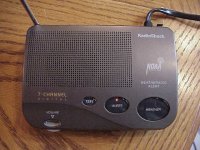DO YOU KNOW WHAT TO DO?
What would you do if severe weather threatened
your area? Let's take a look at the possibilites. First, what
is severe weather? Severe weather is defined as tornadoes, damaging
thunderstorm winds in excess of 55 mph, and large hail 3/4 of an inch in
diameter or larger. Heavy flooding rains and lightning are technically
not
defined as severe weather; however, they can be and are deadly.
For the most up-to-date weather information,
tune to NOAA Weather Radio frequency 162.55 mHz (Monroe area), your local
TV stations, or other EAS outlet. Sources of weather information
have never been so readily available. During the severe weather season,
keep abreast of the weather situation on a daily basis. It only takes
a few moments for a weather briefing. It could save your life.
NOAA WEATHER RADIO
Cannot say enough about this life saving device.
A NOAA weather radio is a device that monitors weather broadcasts 24 hours
a day, seven days a week providing current weather conditions, forecasts,
discussions, advisories, and severe weather watches or warnings.
Although weather radios come in a variety of styles, brand name is a personal
choice for the consumer. However, it is important that you do purchase
one with a weather alert warning tone feature.

These radios receive a special signal from
the National Weather Service (NWS) when a watch or warning is issued for
a specific coverage area. Upon reception of the signal, an alarm
feature is activated on the radio. Some radios sound an alarm or
siren while others simply automatically switch from standby mode to audio
mode. This feature is especially important during the nighttime hours
when most people are asleep.
Prices range from $35 to nearly $100 depending
upon features. However, a good weather radio with alert features
can be purchased for $35 to $40 at nearby department stores such as K-Mart
or Wal-Mart and electronics stores such as RadioShack.
Topics
TORNADOES
THUNDERSTORMS
WINTER
WEATHER
